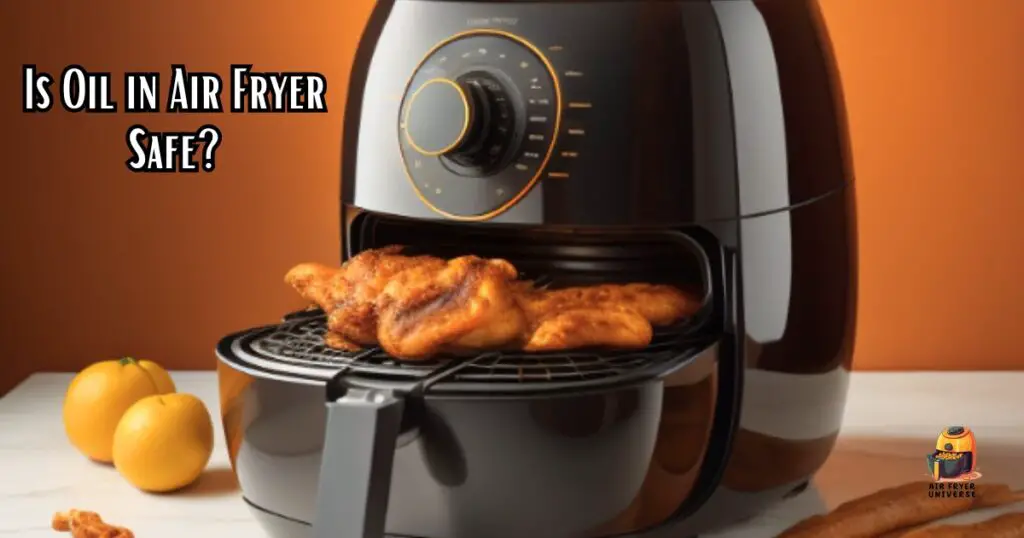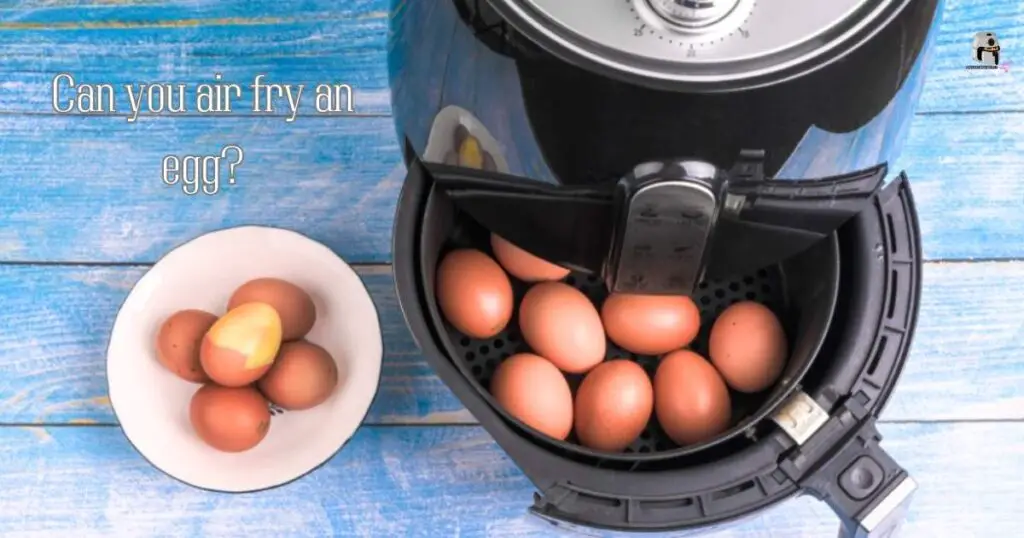Table Of Contents
Yes, using oil is in air fryer safe. Air fryers are designed to cook food with hot, circulating air, and a small amount of oil can be applied to enhance the flavor and texture of certain dishes.
It’s essential to use oil in moderation and follow the manufacturer’s guidelines to prevent oil from dripping into the heating element, which can cause smoking or even a fire.
Coating food lightly with oil or using a spray bottle to apply a thin layer can help achieve a crispy exterior while still keeping the overall cooking process healthier than traditional deep frying.

Why Do I Need Oil in an Air Fryer?
Here are several reasons why you need oil in an air fryer:
Texture Enhancement
Oil is crucial for achieving that coveted crispy and crunchy texture in air-fried dishes. When exposed to the high circulating heat inside the air fryer, the oil plays a fundamental role in the Maillard reaction. This chemical process results in browning and caramelization, giving your food a delightful texture that is both crispy and golden brown.
Flavor Amplification
Oil acts as a carrier for the flavors present in your seasonings and ingredients. It helps distribute these flavors more evenly across the surface of the food, intensifying and enhancing the taste profile of your dishes.
Preventing Stickiness
Foods with coatings or breading can often stick to the air fryer basket or tray. Applying a thin layer of oil serves as a natural non-stick barrier, ensuring that your food doesn’t adhere to the cooking surface. This prevents your food from falling apart and makes it easier to remove once it’s done cooking.
Even Cooking
Oil contributes to even heat distribution. By coating the food, it helps ensure that the heat is dispersed uniformly across the surface, preventing any part from becoming overcooked or undercooked.
Moisture Retention
When cooking in an air fryer, especially with lean cuts of meat, the oil helps trap and retain moisture within the food. This moisture retention is essential for keeping your meats juicy and tender rather than allowing them to dry out during cooking.
Flavor Infusion
Many people use oil as a medium for infusing additional flavors into their dishes. Before applying the oil, they may mix it with herbs, spices, or aromatic oils, introducing a diverse range of flavor profiles.
How to Use Oil in an Air Fryer?
Using oil in an air fryer is a straightforward process. Here are steps on how to use oil in an air fryer effectively:
1. Choose the Right Oil
Select an oil with a high smoke point to avoid generating smoke or unpleasant flavors during cooking. Common choices include canola oil, vegetable oil, peanut oil, grapeseed oil, and avocado oil.
2. Measure the Oil
Be mindful of the amount of oil you use. The objective is to apply a thin, even layer to the food, not to drench it. A teaspoon or two of oil is often sufficient for coating most foods. You can use more for larger batches, but avoid excessive oil, leading to uneven cooking and a greasier result.
4. Consider a Cooking Spray
For precise oil application and minimal usage, consider using a cooking spray specifically designed for air frying. These sprays emit a fine oil mist, ensuring even coverage on your food.
5. Preheat the Air Fryer
Preheating your air fryer is essential. Set it to the desired cooking temperature as indicated in your recipe. Preheating helps start the cooking process immediately, promoting even cooking and a crispier texture.
6. Coat the Food
Place your food in a mixing bowl and lightly drizzle or toss it with the oil. Ensure that the oil is distributed evenly across the food’s surface. For even distribution, you can use your hands or a utensil to coat the food thoroughly. If using a cooking spray, a quick, even spray over the food should suffice.
7. Arrange the Food Properly
Place the oiled food in a single layer inside the air fryer basket or on the tray. Overcrowding should be avoided, as it can impede proper air circulation and result in uneven cooking. If necessary, cook in multiple batches to ensure even results.
8. Follow Cooking Instructions
Refer to your recipe for the recommended time and temperature settings for air frying. The oil-coated food will cook, and the oil will contribute to achieving a crispy, golden-brown exterior while preserving moisture inside.
9. Monitor Doneness
Keep a close eye on the cooking process, especially as it nears completion. Use a meat thermometer to check the internal temperature of meats to ensure they reach a safe level. Different foods will have different target temperatures for doneness.
Read More: Can I Put Olive Oil in Air Fryer
Best Oils for Air Fryer
The best oils for air fryers are those with high smoke points and neutral flavors. Some of the best options are as follows:
Avocado Oil (Smoke Point: 520°F)
Avocado oil is one of the top choices for air frying due to its exceptionally high smoke point. Beyond its impressive heat tolerance, it boasts a neutral flavor profile, making it an ideal choice for a wide range of dishes. Additionally, avocado oil is rich in heart-healthy unsaturated fats, adding a healthful dimension to your cooking.
Light Olive Oil (Smoke Point: 465-470°F)
Often labeled as “light” or “extra light,” refined olive oil has a higher smoke point compared to extra virgin olive oil. The term “light” refers to its color and neutral taste rather than its calorie or fat content. It is produced by heating virgin olive oil after the initial pressing, resulting in a golden yellow hue. Refined olive oil offers a longer shelf life and higher smoke point, making it suitable for air frying when you prefer the milder flavor of olive oil.
Clarified Butter (Ghee) (Smoke Point: 482°F)
Clarified butter, also known as ghee, is a staple in both French and Indian cuisine. It is regular butter with its milk solids and water content removed, leaving behind pure, golden fat. With a significantly higher smoke point than regular butter, ghee is an excellent choice for air frying. It adds a delightful richness and depth of flavor to your dishes.
Sunflower Oil (Smoke Point: 450°F)
Pressed from sunflower seeds, sunflower oil is celebrated for its vitamin E content and abundance of unsaturated fats. Its light, neutral flavor and high smoke point make it a versatile option for air frying, ensuring that it won’t overpower your dishes with any distinctive taste.
Peanut Oil (Smoke Point: 450°F)
Known for its pleasant, nutty flavor and high smoke point, peanut oil is frequently used in stir-frying and deep frying. Its robust flavor can enhance the taste of your air-fried creations, making it particularly suitable for dishes where a nutty undertone is desired.
Grapeseed Oil (Smoke Point: 421°F)
Grapeseed oil is a byproduct of winemaking, extracted from grape seeds after grapes are pressed for wine production. Rich in vitamin E and unsaturated fats, grapeseed oil boasts a high smoke point and a clean, mild taste. Its versatility makes it a valuable all-purpose cooking oil.
Refined Coconut Oil (Smoke Point: 400°F)
Coconut oil has gained popularity due to its unique fatty acid composition and potential health benefits. However, it’s essential to choose refined coconut oil for air frying rather than unrefined coconut oil, which has a lower smoke point of 350°F. Refined coconut oil offers a neutral flavor and the desired heat tolerance for air frying.
What Oil Should You Not Use in an Air Fryer?
While most cooking oils are suitable for use in an air fryer, there are a few types of oil that you should avoid or use with caution due to their low smoke points or strong flavors. Here are some oils you should generally avoid using in an air fryer:
- Extra Virgin Olive Oil (EVOO)
Extra virgin olive oil is prized for its rich flavor and health benefits. However, it has a relatively low smoke point, typically ranging from 320°F to 374°F (160°C to 190°C). When used in an air fryer at high temperatures, EVOO can produce smoke and develop a bitter taste. It’s best reserved for low-heat cooking, drizzling on salads, or adding to dishes after air frying.
- Butter
Butter is a flavorful fat with a low smoke point, usually around 350°F (177°C), due to its milk solids and water content. Using butter in an air fryer at high temperatures can result in burning and smoke. If you desire butter taste, consider using clarified butter (ghee), which has a higher smoke point and is more suitable for air frying.
- Unrefined Coconut Oil
Unrefined or virgin coconut oil has a smoke point of around 350°F (177°C). While it’s a popular choice for some cooking methods, it may not be ideal for high-temperature air frying. If you prefer to use coconut oil in your air fryer, opt for refined coconut oil, which has a higher smoke point, usually around 400°F (204°C).
- Flavored Oils
Oils infused with strong flavors, such as garlic or chili oil, can pose challenges in an air fryer. The intense heat can amplify these flavors, potentially overwhelming your dish. It’s advisable to avoid these flavored oils in favor of using herbs, spices, or other flavorings directly on your food.
- Sesame Oil
Sesame oil, particularly toasted sesame oil, has a relatively low smoke point, typically around 350°F (177°C). This renders it unsuitable for high-temperature air frying. Instead, consider using sesame oil as a finishing touch by drizzling it on your dish after air frying for added flavor.
- Walnut Oil
Walnut oil is known for its nutty aroma and taste. However, it has a low smoke point, usually around 320°F (160°C). Air frying with walnut oil is not recommended, as it can quickly reach its smoke point and impart a burnt taste to your food.
- Flaxseed Oil
Flaxseed oil has an exceptionally low smoke point, approximately 225°F (107°C). It’s unsuitable for any high-heat cooking method, including air frying. Flaxseed oil is best reserved for salad dressings and other cold applications.
Considerations When Using Oil in Air Fryer
When using oil in an air fryer, there are several important considerations to keep in mind to ensure successful and safe cooking. Here are some key considerations:
- Oils with high smoke points are crucial for air frying. These oils can endure the high temperatures inside the air fryer without breaking down or producing smoke. They ensure safe and efficient cooking.
- The goal when using oil in an air fryer is to provide a light, even coating on the food. Using too much oil can lead to excessive greasiness and may not yield the desired crispy texture. A general guideline is 1-2 teaspoons of oil per serving but adjust according to your recipe and preference.
- Cooking sprays designed for air frying are a convenient option. They emit a fine mist of oil, resulting in precise and uniform coverage of the food. Cooking sprays are especially useful when you want to minimize oil usage.
- Preheating your air fryer to the specified temperature in your recipe is essential. It jumpstarts the cooking process, ensuring that your food cooks evenly and becomes crispier.
- To guarantee an even distribution of oil, toss, mix, or brush the oil onto the food before placing it in the air fryer. This step is crucial for consistent results and helps prevent dry spots or excessive oil pooling.
- Overcrowding the air fryer basket can impede proper air circulation, leading to uneven cooking. To ensure that your food cooks evenly and achieves a crispy texture, arrange it in a single layer with some space between each piece.
- Keep a close eye on the cooking process, especially as it nears completion. Overcooking can result in dry or burnt food. Use a meat thermometer to check the internal temperature of meats to ensure they reach the desired level of doneness.
- Different air fryer models and food items may require adjustments to cooking times and temperatures. Be prepared to fine-tune these settings based on your specific cooking needs.
- Consider the impact of oil flavor on your dish. Some oils, like peanut or sesame oil, have distinct tastes that can enhance certain cuisines or recipes. Neutral oils like canola or vegetable oil allow the natural flavors of the food to shine through.
- Oil residue can build up over time, affecting the performance and taste of your air-fried dishes. Regularly clean the air fryer components, including the basket, tray, and any removable parts, to maintain optimal cooking conditions.
- Follow recipes and guidelines provided by your air fryer’s manufacturer or trusted sources. These resources offer valuable insights into oil usage specific to your appliance.
FAQs
Is It Better to Air Fry With or Without Oil?
When using the air fryer, you typically don’t need to add extra oil, although it’s not mandatory. However, for certain recipes like breaded chicken cutlets or vegetables, a small amount of oil can work wonders. It not only contributes to a lovely golden appearance but also enhances the overall texture and flavor of the dish.
Where Do You Put Oil in an Air Fryer?
When air frying, it’s essential to put the oil on the food itself, not in the air fryer basket. Toss, brush, or spray the food with a small amount of oil to ensure even coating before placing it in the air fryer basket or tray.
How Much Oil Do I Put in My Air Fryer?
Air Fryer Recipes typically specify the required oil amount to achieve the desired texture and flavor. However, as a rule of thumb, you can start with a tablespoon of oil and adjust it based on your preference. If you’re using an oil sprayer, a couple of spritzes are usually adequate for even coverage.
Can I Use Olive Oil in the Air Fryer?
Yes, you can use olive oil in the air fryer. Certainly, heart-healthy olive oil is suitable for the air fryer. Opt for refined olive oil, such as light or extra light olive oil, as it boasts a higher smoke point compared to extra virgin olive oil, ensuring safe and effective air frying.
Final Verdict
In the realm of air frying, oil is not only safe but also a valuable tool for achieving delicious, crispy results. The key to safety lies in choosing oils with high smoke points to prevent harmful compounds. Applying oil judiciously and evenly on your food enhances texture and flavor without excess grease.
When used thoughtfully, air frying offers the best of both worlds: the irresistible crunch of fried foods with minimal oil, making it a remarkably safe and healthy alternative to traditional deep frying. Embrace the sizzle, flavor, and health benefits of air frying with confidence!
You May Also Like to Read:


